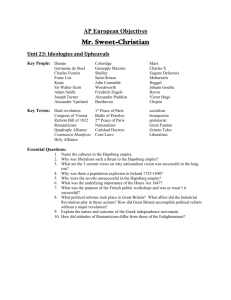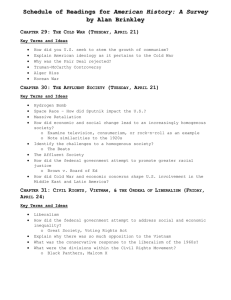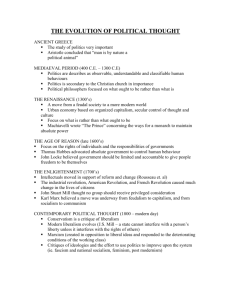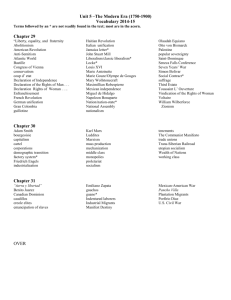Liberalism, Conservatism, Nationalism, Romanticism
advertisement
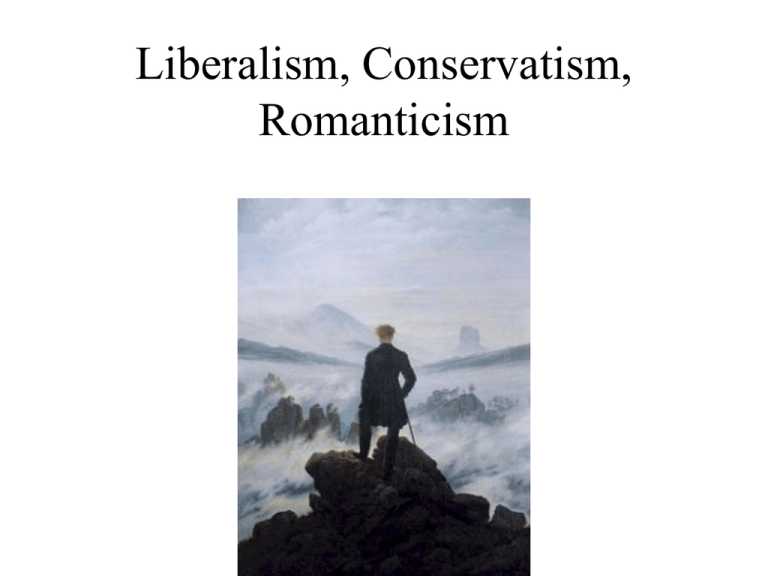
Liberalism, Conservatism, Romanticism Definitions • Liberalism- Originated in the 19th Century, based on the idea that political change can make a society better than before. It supported democracy, laissez-faire and the removal of the Corn Laws. This movement led to utilitarianism and the reform movement. • Nationalism- is the idea that everyone with the same language, traditions, ideas, ideals, culture, heritage, etc. should have their own nation, and love that nation • Romanticism- was an artistic movement in the mid to late 1800s. Depicted the beauty of nature and opposed the Scientific Revolution. "Sturm und Drang"= Storm and Stress which was a German movement to counter the Scientific Revolution and the Enlightenment. • Communism- is the economic system that puts ALL power in the hands of the government so they can manage it "for the good of the people". It originates from Marx's ideas, but it was changed by Russia, with Lenin and his successors who made "communism" that was very similar to Marxism. Conservatism: Preservation of the Established Order • Conservatism was a reaction to the excesses of the Enlightenment and the French Revolution. It meant to contain the liberal and nationalist forces that were unleashed by the French Revolution and Napoleon • Beliefs – Favored obedience to political authority – Organized religion was crucial to social order – Hated revolutionary upheavals – Unwilling to accept liberal demands for civil liberties or nationalistic aspirations – Community took precedence over individual rights – Society must be organized and orderly – Tradition remained the best guide for order Edmund Burke • Its leading theorist was Edmund Burke who: – Viewed the social order as a partnership between past, present, and future. – Rejected the notion of equality or natural rights. – Argued that rights were inherited from the past.- aka where you were born and your family – Believed monarchy was the form of government most capable of protecting peoples' rights. – Accepted gradual change (unlike reactionaries). Conservative Domination: Concert of Europe • Concert of Europe was seen as a means to maintain the new status quo – Quadruple Alliance of GB, Prussia, Austria & Russia • Held several conferences from 1818-1822 – Aix-la-Chapelle (1818); France is added forming Quintuple Alliance – Troppau (1820) • Called to discuss the outbreak of revolution in Spain and Italy • Metternich calls for intervention to restore the legitimate monarchs to their thrones Intervention by the Great Powers • • • • • Protocol of Troppau authorizes the intervention of the Alliance, though the British are hesitant Other members ignore Britain’s reservations and Britain withdraws Austria, Prussia, and Russia meet at Laibach in 1821 and authorize intervention in Italy Verona, 1822 – three powers authorize French intervention in Spain to restore Bourbons The success of the policy of intervention has its cost as the Concert of Europe is broken The Conservative Domination: Britain • • • • • • Landed aristocracy still dominated both houses of Parliament and thus government Suffrage was still very limited and unequal The new industrial cities of Birmingham and Manchester had no representatives while the gentry dominated through their control of pocket and rotten boroughs The Tories and the Corn Law (1815) Discontent among the working class and the Peterloo Massacre (1819) Minor reforms hold off any major electoral reforms until the 1830’s The Conservative Domination: Bourbon Restoration in France • • • • Restoration of Louis XVIII in 1814 Recognized that some of the reforms of the Revolution and Napoleon had to be accepted - the Civil Code and property rights were preserved He also established a bi-cameral legislature whose lower house, the Chamber of Deputies, was chosen by an electorate no more than 100,000 wealthy people Problems with the Ultra Royalists Origins of 19c Liberalism • The word was first used when the term was adopted by the Spanish political party, the Liberales, in 1812. • The roots of liberalism came from two very different traditions of English & French political thought. – England • John Locke • Adam Smith – France • Jean Jacques Rousseau • Francois Guizot John Locke • Contract theory of government. – Regarded the state as a human construction, established by an original contract. • Limited, constitutional government. – Civil society of free men, equal under the rule of law, bound together by no common purpose but sharing respect for each other’s rights. – Doctrine of natural rights. – Links private property with individual liberty. Adam Smith • His Wealth of Nations adds an economic dimension. • He merged Locke’s ideas of civil society with economic theory. – Free trade economics. – Saw the “invisible hand” where a benevolent God administered a universe in which human happiness was maximized. John Stuart Mill (1806-1873) • Wrote works on logic and metaphysics, history and literature, economics and political theory. • A utilitarian: – The greatest happiness for the greatest number. • Wrote On Liberty in 1859. On Liberty (1859) • Government might be antagonistic to the causes of individual freedom. • The sole purpose of government is “self-protection.” • Government may only coerce others in self-defense. • We should maximize human development for a more equal society: – Mill favored a more open administration. – Organized interest groups. – Workers cooperatives • Workers would own the factories and elect the managers. – Tax wealth. – Redistribution system of wealth: • Confiscation of excess profits • Abolish the wage system. – Emancipation of women. Classical Liberalism in England • Important legislation: – Catholic Emancipation Act of 1829. – Reform Act of 1832. – Factory Act of 1833. – Repeal of the Corn Laws in 1846. Religious Toleration: Catholic Emancipation Act • The Test and Corporations Act was repealed in 1828 – this piece of law dated back to Charles II and banned anyone who did not take communion in the Church of England from holding office in either central or local government • The following year came the Catholic Relief Act granting similar rights to Roman Catholics Catholic Relief Act • This was brought to a head by Daniel O’Donnell, who won a by election in County Clare in 1828, but as a catholic was not allowed to attend Parliament. • This triggered a tremendous wave of support for catholic emancipation throughout Ireland. • Wellington (Tory PM) feared that to refuse O’Connell his seat would cause an open revolt in Ireland and therefore introduced Catholic Emancipation mainly to avoid this. This was to prove especially difficult as in losing most of the liberal Tories earlier from his government he was left with a party that stood strongly against rights for Catholics. 4 The Demand For Change – The Industrial Revolution • Before 1750 most people in Britain worked on the land. • New machinery was developed to produce goods These machines were housed in huge buildings called ‘factories’. • Towns/cities grew rapidly as people from the countryside moved to find work. • The owners of these factories and industries became rich and were known as the ‘middle classes’. • The middle classes did not have the right to vote at election. • Major towns and cities did not have any MPs in Parliament to represent them. Reform Begins • The British government was worried that if they didn’t introduce reforms, revolution would happen – ordinary people would try to overthrow the government by force. • This had happened in countries like France, Germany and Italy. • Reform means ‘a change for the better’. The Great Reform Bill • The Great Reform Bill was first introduced to the House of Commons in March 1831 and passed its second reading by one vote. • At committee stage (when clauses of bill are scrutinized) the bill was defeated. • Grey resigned and asked the King to dissolve Parliament – at the subsequent election the Whigs were returned to government with a large majority of 136. • A slightly amended reform bill was introduced, passed through all its stages in the Commons, was presented to the House of Lords in October 1831 who promptly threw it out. Agitation for the Bill • Widespread demonstrations now occurred throughout the country – there were pro-Reform Bill riots in Bristol, London and the Midlands. • A third Bill was introduced by the Whigs in December 1831 – again it passed through its three readings in the Commons and this time got as far as third reading in the Lords (committee stage). At this point the Lords tried delaying tactics. • Grey asked the King to create 50 new Lords to push the Bill through, the King refused and the government resigned again! Return of Wellington • Running short of options the King then asked Wellington to try and form a government in the hope that the ‘iron duke’ would be able to get some sort of watered down version of the reform bill through Parliament. • At this prospect there was a a mass of agitation in the country against Wellington and the Tories and for the ‘whole bill’ • Radicals organised both an income tax strike and a run on the banks by encouraging everyone to withdraw their savings deposits. • With Revolution staring him in the face Wellington and the King retreated and within a week the Whigs and Grey were back in power on their own terms. Wellington instructed Tory Lords not to resist the bill any further and the King promised to create enough new Whig lords to get it through anyway. • The Great reform Act finally became law in May 1832 after over a year of bitter struggle So What Changed? • Not much! • The franchise (who could vote) was made more uniform and the electorate extended by about 250,000 voters most of whom were middle class – only about 1:7 adult males had the vote after the Reform Act • 56 rotten and pocket boroughs were abolished • 30 slightly less rotten boroughs lost one MP • Industrial towns such as Manchester, Birmingham, Leeds, Sheffield got MPs for the first time but the constituencies were still very far from equal • Open boroughs were abolished so some working men lost the vote • Open voting remained and therefore so did electoral bribery and bullying • There was still a high property qualification to be an MP • Despite a few more radical M.P’s the landed aristocracy still held sway in Parliament So Why is it called the GREAT Reform Act? • It was the first of its kind – it was a beginning – a first step towards democracy • The old Tory argument that the British Constitution was an organic living thing which could be killed if pruned had been proven false. • The GRA gave the new middle class a share of power and paved the way for a series of social reforms by the Whigs. • The GRA changed the Tory Party for good – by 1835 they were relaunched as the ‘Conservatives’ no longer resistant to all change or reform as a matter of principle Classical Liberalism in France • Dilemmas faced by French liberals: – How to ‘end’ the French Revolution? – How to reconcile order and liberty in a nation torn apart by civil war? • These problems called for a rethinking of Liberalism. Jean Jacques Rousseau • His Social Contract and theory of the “general will” demonstrates an alternative origin of Liberalism. – Men must resolve problems through our capacity to choose how we ought to live. • Man was born free, and he is everywhere in chains. • Humans are essentially free, but the ‘progress’ of civilization has substituted subservience to others for that freedom. Rousseau & Totalitarianism • The “General Will” a strong and direct form of democracy. – Only possible in a relatively small state? – Is Rousseau promoting collective tyranny? • Rousseau rejected representative democracy. Francois Guizot • He ‘deconstructed’ the French Revolution, and distinguished between “Moderate Liberalism” and extremist Jacobinism. “Moderate” Liberalism 1. Favored the idea of the sovereignty of the people, but… – Government should rest on the organized consent of at least the most important sections of the community. – An extension of the franchise to include all men of property. • Exclude the working class! 2. A good constitutional monarchy was the best form of government. 3. Valued liberty more than equality. – Confidence in man’s powers of self-government and selfcontrol. – Freedom of the press. – Free right of assembly. 4. Written constitutions. “Moderate” Liberalism 5. Economic policies: – Laissez-faire economy. – Free trade. – Lower tariffs. – Against the right of the working class to organize into unions. 6. The general progress of humanity would emerge from the growth of wealth and from science and inventions. 7. Established churches & the landed aristocracy were obstacles to the advancement of civilization. 8. Orderly change by legislative process. 9. A dislike of wars, conquests, a standing army, and military expenditures. 10. Hated the idea of revolution! Challenges to Liberalism • From above the conservative upper class. • From below socialism/Marxism. • From organized religions. • From militarism and imperialism. • From economic upheavals: – Irish Potato Famine [1845-1852]. – Great Depressions [1873-1896]. The Spirit of the Age (1790-1850) A sense of a shared vision among the Romantics. Early support of the French Revolution. Rise of the individual alienation. Dehumanization of industrialization. Radical poetics / politics an obsession with violent change. A Growing Distrust of Reason Enlightenment Society is good, curbing violent impulses! Early 19c Romanticism Civilization corrupts! e The essence of human experience is subjective and emotional. e Human knowledge is a puny thing compared to other great historical forces. e “Individual rights” are dangerous efforts at selfishness the community is more important. The Romantic Movement Began in the 1790s and peaked in the 1820s. Mostly in Northern Europe, especially in Britain and Germany. A reaction against classicism. The “Romantic Hero:” Greatest example was Lord Byron Tremendously popular among the European reading public. Youth imitated his haughtiness and rebelliousness. Characteristics of Romanticism The Engaged & Enraged Artist: The artist apart from society. The artist as social critic/revolutionary. The artist as genius. Characteristics of Romanticism The Individual/ The Dreamer: Individuals have unique, endless potential. Self-realization comes through art Artists are the true philosophers. Glorification of Nature: Peaceful, restorative qualities [an escape from industrialization and the dehumanization it creates]. Awesome, powerful, horrifying aspects of nature. Indifferent to the fate of humans. Overwhelming power of nature. Characteristics of Romanticism The Supernatural: Ghosts, fairies, witches, demons. The shadows of the mind—dreams & madness. The romantics rejected materialism in pursuit of spiritual self-awareness. They yearned for the unknown and the unknowable. Exoticism: The sexy “other.” A sense of escape from reality. A psychological/moral justification of imperialism? Other Characteristics • • • • • Science can be Dangerous New Technology is Dehumanizing Romanticizing Country Life Nationalism Romanticizing the Middle Ages Gothic & Romanesque revival. “Neo-Gothic” architectural style. Medieval ruins were a favorite theme for art and poetry. The Great Age of the Novel Gothic Novel: Jane Eyre - Charlotte Bronte (1847) Wuthering Heights - Emily Bronte (1847) Historical Novel: Ivanhoe - Sir Walter Scott (1819) Les Miserables - Victor Hugo (1862) The Three Musketeers – Alexander Dumas (1844) Science Science Fiction Novel: Frankenstein - Mary Shelley (1817) Dracula – Bramm Stoker (1897) Novel of Purpose: Hugh Trevar - Thomas Holcroft (1794) The Romantic Poets Percy Byssche Shelley Lord Byron (George Gordon) Samuel Taylor Coleridge William Wordsworth John Keats William Blake The Political Implications Romanticism could reinforce the greatest themes of political liberalism or political conservatism. Contributed to growing nationalist movements. The concepts of the Volk and the Volkgeist. The uniqueness of cultures was emphasized.
